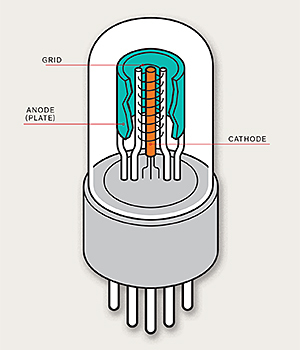Vacuum transistor will be able to overcome the line of 1 THz
 In the second half of the 20th century, silicon transistors (MOSFET) completely replaced radio tubes in electronic devices. This is quite natural, given the numerous advantages of semiconductors: miniature, low cost, efficiency, durability, reliability, and most importantly, an effective technical process for chemical etching of transistors in integrated circuits. The technology allowed to create chips with billions of transistors. Over the years, they became less and less, the distance between the source and drain decreased, due to which the electronics performance increased (Moore's law).
In the second half of the 20th century, silicon transistors (MOSFET) completely replaced radio tubes in electronic devices. This is quite natural, given the numerous advantages of semiconductors: miniature, low cost, efficiency, durability, reliability, and most importantly, an effective technical process for chemical etching of transistors in integrated circuits. The technology allowed to create chips with billions of transistors. Over the years, they became less and less, the distance between the source and drain decreased, due to which the electronics performance increased (Moore's law).Despite these shortcomings, electron tubes have certain advantages over transistors: vacuum itself is a better medium for electron transfer than a solid body, where interference occurs due to electron collisions with material atoms, noise and distortion. In addition, radio tubes are more resistant to radiation damage.
If vacuum is used in conventional transistors, then it would be possible to combine the advantages of both technologies. Theoretically, a vacuum transistor can operate at terahertz frequencies, an order of magnitude faster than existing silicon analogs. Employees of the NASA Ames research center have been experimenting in this direction for a long time. They managed to achieve quite promising results, writes IEEE Spectrum.
Silicon chips have come to the physical limits of miniaturization, and now several areas for further technology development are being considered: carbon nanotubes, graphene, nanowires, and so on. The vacuum-channel transistor (vacuum-channel transistor) complements this list.
')

In a radio tube, an electronic filament, similar to a filament in an incandescent lamp, heats the cathode to such an extent that it emits electrons. This design is the reason for the high power consumption and low reliability of the radio tubes, which often burn out. But in the vacuum-channel transistor there is no filament, and the cathode does not need to be heated.
If the device is made of a miniature size, then field emission becomes possible under the action of an external electric field without first exciting the electrons.
The problem with the presence of a pure vacuum under pressure was determined by NASA Ames engineers by reducing the distance between the cathode and the anode so that it becomes shorter than the electron mean free path before it collides with a gas molecule. At normal atmospheric pressure, the mean free path of an electron is about 200 nm. And if you use helium, it increases to 1 micron. At a sufficiently low voltage, electrons do not have enough energy to ionize helium, so that degradation of the cathode does not occur.
In the prototype of the NASA Ames vacuum transistor, a standard silicon dioxide gate is used to control the transistor, as in the MOSFET.
“Although our work is still at an early stage, we believe that the improvements we have made in the design of vacuum-channel transistors may sometime have a significant impact on the electronics industry, especially in applications where performance is important,” the researchers write. “Our first prototype operates at 460 gigahertz, which is about 10 times higher than the best silicon transistor.”
Engineers believe that it is the vacuum transistor that will be the first to overcome the line 1 terahertz.

True, it is necessary to solve several problems, including with energy consumption. The NASA Ames vacuum transistor is powered by 10 volts. We also need to find a way to accommodate a variety of vacuum transistors on a single chip.
Source: https://habr.com/ru/post/227433/
All Articles